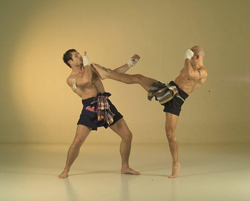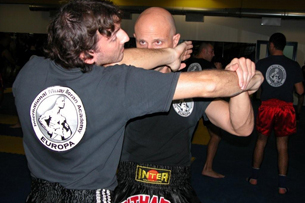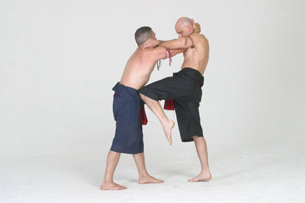Nawarthawut, the arsenal of Muay Thai.
by Marco De Cesaris
 Muay Thai is known as the Martial Art of the nine weapons or Nawarthawut: hands, elbows, legs, knees and head are conditioned and prepared to be used as a means of attack, like axes, daggers, spears and maces. Moreover, the same body parts are used skilfully as protective shields to neutralize the attacks by adversaries in an effective and often definitive way, as a real attack.
Muay Thai is known as the Martial Art of the nine weapons or Nawarthawut: hands, elbows, legs, knees and head are conditioned and prepared to be used as a means of attack, like axes, daggers, spears and maces. Moreover, the same body parts are used skilfully as protective shields to neutralize the attacks by adversaries in an effective and often definitive way, as a real attack.
In Siamese tradition, as we see in many Eastern arts of combat, the first element which is studied to develop the actions of attack is the hand: the base of this kind of attacks is the closed fist, where we use the front part to hit, following different paths, with the back and lower side of the little finger (Note: as a second choice we have an alternative use of the hands, using as a striking part the open hand, placed in several ways, but we don’t deal with it in this article). In order to properly put the fist and to avoid any injury during the performance of the strokes (of course if we are not wearing any type of protective gloves), it is necessary to have some techniques: it is necessary to press strongly the fingers in the crucial moment of impact on the target, and the wrist must be kept rigid, aligning the back of the fist with the forearm, avoiding to bend it, otherwise we will suffer a serious injury and our fight will be over.
The trajectories of the strokes can be different; normally the attacks are divided into direct blows and circular blows; the circular blows can be performed from the bottom, parallel to the ground, or from above, in rotation.
Of course, the elbow is considered one of the hardest parts of the body and when it is properly placed and used by any expert Thai boxer, it may become the ultimate weapon. The first element to be considered in order to effectively use the elbow is to learn how to properly form a weapon with our own elbow; the arm and the forearm should be strongly linked, so that the tip of the elbow comes out, which has to be like an awl to cause as much damage as possible in the action of attack.
The trajectories of the elbow blows are numerous, and the shoulder joint can move 360° relatively easily; elbow blows can be performed from above, from below, diagonally, horizontally, in rotation. These blows can reach virtually every part of the adversary’s body depending on the variety of angles, hurting each target. It is also important to consider that, besides the most obvious movements of the shoulders, also the trunk and legs contribute to the effective performance of the elbow blows.
Certainly the legs are much more powerful than the arms; in Thai tradition the use of the legs as weapons of attack and defense has always been very common.
In general, in Muay Thai there are two areas as points of impact for the leg attacks: the feet and the tibia. The feet are used in kicking with direct trajectory and they impact on the fingers, the forefoot, the sole, the heel; an exception to this rule is some blows where some parts of the foot, such as the back and the neck of the foot (besides the heel, the outer court and the sole) are used as an impact surface for certain individual kicks. In contrast, the other primary area of impact for kicks, the tibia, is used in most of the kicks with a circular trajectory and to perform defensive actions. The tibia is one of the toughest bone parts, however, we must prepare it properly, otherwise its sensitivity could be counterproductive for the performer of the action of attack. With regard to the trajectories of these blows, in the performance of direct kicks, depending on the position of the hip, there are three kinds of attack: front, side or behind. In contrast, circular kicks are identified in the base of the angle formed by the leg with the ground: so we will have vertical, diagonal, horizontal, parable or back kicks.
Without any doubt, the knees are the natural weapons which have been used more deeply over the centuries by the Thai Kru; in no other martial the knee blows were developed more than in Muay Thai. Regarding the most suitable position of the leg to perform the knee blows, it is more or less the same as we said for the elbows: the leg has to be aligned with the thigh to allow the front part to be harder when moving outward, creating a compact surface which can cause incredible damage to any part of the adversary. In addition to the front part, also the inside part of the knee is used in the performance of some types of circular blows. The trajectories of the knee blows move forward, upward, in circles, downward, and when they are combined with the use of certain fight grabbing, they can easily reach all the sensitive parts of the body, from the legs to the head.
The ninth weapon is the head, often considered as a brilliant mind which acts as a command center to coordinate in the best way the eight basic weapons which can be used by the Nak Muay or Thai Boxer. In fact, also its anatomical part, the skull, is very important in the arsenal of Muay Thai, especially in the tough stages of hand to hand combat (among the toughest we may face). The front and back parts of the head are used intelligently, often in combination with grabbing, as it happens with the knee blows, to impact with violence on the adversary’s face or trunk: often they stand out as definitive techniques, as well as the other eight essential weapons of Muay Thai.
 |
 |